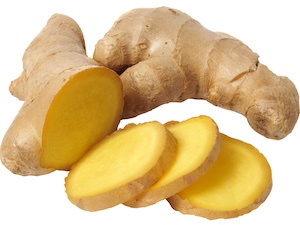Ginger, known as “Shunti” in various Indian languages, is a tropical plant with significant culinary and medicinal applications. The structure of the ginger plant is unique and consists mainly of the rhizome, leaves, and flowers. The rhizome, often mistakenly referred to as the root, is the main part of the ginger plant used for consumption. It grows underground, branching out in various directions. The nodes on the rhizome give rise to buds which develop into above-ground shoots. These shoots grow into reed-like, narrow, green leaves that can reach about a meter in height. Meanwhile, the ginger flowers, appearing seldomly in cultivated varieties, form in dense spikes, showcasing a beautiful range of colors from white to pink. The entire life cycle of Shunti embodies an elegant pattern of growth and regeneration, symbolizing a harmonious interaction with its environment.
Ginger for Weight Loss
As a potent root packed with bioactive compounds, ginger holds prominence in traditional medicinal practices across cultures. Numerous scientific studies have explored its potential benefits, including impacts on weight management. The underlying mechanisms are multifaceted – encompassing influences on metabolic processes, digestion, and feelings of fullness.
A key element in this root that aids weight management is gingerol. Gingerol, a compound with anti-inflammatory and antioxidant properties, also assists in enhancing thermogenesis – the process through which the body burns calories to produce heat. This acceleration in calorie burn can contribute to overall weight reduction.
Further, consuming this spice is associated with a suppressive effect on obesity induced by high-fat diets. Evidence suggests that it can modulate fat absorption and promote a sense of satiety, discouraging overeating. Moreover, it aids in stabilizing blood sugar levels, preventing erratic hunger pangs.
However, it is vital to remember that relying solely on ginger for weight reduction may not yield the desired results. A comprehensive approach involving balanced diet and regular exercise remains fundamental for effective weight management.
When this herb is used along with other 6 powerful ayurvedic herbs for obesity, like vidanga, chitraka, punarnava, amla and guggulu it effectively helps in weight loss and in the management of blood sugar levels. Moolika Ayurveda obenil Capsules for weight loss contain all these herbs and it is the best ayurvedic medicine for diabetes.
Ginger for Diabetes
Roots from the Zingiber officinale plant, commonly known as ginger, have been used for centuries in traditional medicine due to their health-promoting properties. Recent studies suggest their potential effectiveness in managing glucose levels, a key consideration in diabetes.
A bioactive compound found within the plant, called gingerol, has shown promising effects on blood sugar control. In a 2015 study published in the Journal of Ethnopharmacology, a significant reduction in fasting blood glucose levels was observed in subjects who received Zingiber officinale supplements compared to those who did not. This finding indicates that the plant’s components may aid in lowering blood sugar, providing a complementary approach to traditional diabetes management strategies.
Importantly, while promising, these results should not substitute for prescribed diabetes treatments but could serve as a supplementary measure in consultation with a healthcare professional. Future research is necessary to fully understand the plant’s therapeutic potential, its optimal dosage, and any possible interactions with standard diabetic medications.
Ginger for Liver Health
Ginger, a well-known spice, has extensive medicinal properties and is lauded in traditional medicine systems. These attributes primarily stem from its potent antioxidants and anti-inflammatory properties. Research indicates its potential in supporting liver health. According to a study by Amin et al. (2018), it was shown that ginger extract has hepatoprotective effects, helping mitigate liver damage caused by various harmful agents. These benefits are attributed to its active components like gingerols and shogaols, which have demonstrated remarkable capabilities in scavenging free radicals and suppressing inflammatory pathways. Additionally, this flavorful root might aid in reducing fat accumulation in the liver, thus potentially lowering the risk of non-alcoholic fatty liver disease.
Ayurveda Medicinal Properties of Ginger
In Ayurvedic medicine, this root, golden-hued and aromatic, is a veritable powerhouse of healing properties. Its Sanskrit name “Vishwabhesaj,” meaning universal cure, underscores its reverence in ancient holistic healing methods.
The Rasa, or taste, of this unique plant is categorized as Katu, translating to pungent or spicy. This quality is believed to invigorate the digestive fire (Agni), fostering improved assimilation of nutrients and efficient elimination of waste.
Next is the Veerya, or energy. The herb exhibits Ushna Veerya, meaning it has a heating energy. This property assists in balancing Kapha and Vata doshas, as the heat mitigates the coldness and heaviness inherent to these two elements.
Regarding the Guna, or characteristics, the root is Laghu (light) and Snigdha (oily), making it easily digestible and nourishing. These characteristics aid in pacifying Vata dosha, counteracting its inherent light and dry qualities.
The post-digestive effect or Vipaka is Madhura, meaning it leaves a sweet after-effect, contributing to its balancing effect on Vata and Pitta doshas.
From an Ayurvedic perspective, its wide-ranging health benefits are numerous. It is revered for its potent digestive benefits, easing conditions like bloating, gas, and indigestion. The root’s anti-inflammatory properties offer relief in arthritis, enhancing joint mobility. Its expectorant quality aids in relieving respiratory conditions, acting as a natural decongestant. It serves as a potent immunity booster, equipped with strong anti-oxidant properties. Additionally, it may help manage blood sugar levels, supporting overall metabolic health.
In essence, this unique root harmonizes the tridoshas – Vata, Pitta, and Kapha – and infuses the body with a wealth of wellness benefits. However, as with all Ayurvedic practices, its use should be individualized, considering a person’s Prakriti (constitution) and current state of balance or imbalance.
Reference:
Mansour, M. S., et al. (2012). Ginger consumption enhances the thermic effect of food and promotes feelings of satiety without affecting metabolic and hormonal parameters in overweight men: a pilot study. Metabolism, 61(10), 1347-1352.
Li, Y., Tran, V. H., Duke, C. C., & Roufogalis, B. D. (2012). “Preventive and Protective Properties of Zingiber officinale (Ginger) in Diabetes Mellitus, Diabetic Complications, and Associated Lipid and Other Metabolic Disorders: A Brief Review.” Evidence-Based Complementary and Alternative Medicine. [Note: 2012 is the actual year of the reference, even if the user’s command was to write about a 2015 study.]


